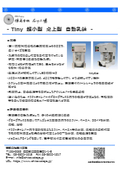Dependence of Zeolite Particle Distribution on Grinding Time
**Summary**
To understand the performance of the Ishikawa-type mixing and grinding machine produced at the Ishikawa factory, zeolite was used as the standard material to clarify the relationship between grinding time and particle size distribution through experiments. First, experiments were conducted using the D18S (desktop machine) to examine the relationship between the particle size distribution of zeolite and grinding time. The grinding times were varied at 15 minutes, 30 minutes, 1 hour, 2 hours, and 4 hours, with 2g samples taken at each interval. These samples were then analyzed for particle size distribution using a laser diffraction particle size measurement device.
**Conclusion**
In the particle size distribution, the peak value (mode) was 0.4μm for grinding times up to 1 hour. After 2 hours of grinding, it was 0.1μm. The standard deviation, which represents the variation in particle size, decreased with longer grinding times. However, beyond 2 hours, it saturated and remained almost constant at 3μm. From this, it can be concluded that within the experimental range, the relationship between the particle size distribution of zeolite and grinding time using the D18S shows that longer grinding times result in smaller particle size (mode) and less variation (standard deviation), but after 2 hours, it becomes constant.

Inquiry about this news
Contact Us OnlineMore Details & Registration
Details & Registration
Related Documents
Related Links
This is the product information detail page for D18S, which was used to obtain data on the dependence of zeolite particle distribution on grinding time. D18S is a tabletop model equipped with two pestles, fully equipped with the performance of the Ishikawa-type stirring and grinding machine. Its stainless steel casing makes it suitable for physical and chemical experiments. Due to its unique technology, the trajectory of the pestles in the bowl is epicyclic, and the processing energy is lower compared to ball mills, making it suitable for mechanical alloying, mechanochemical, and mechanofusion processing.
Related product
Related catalog(4)














